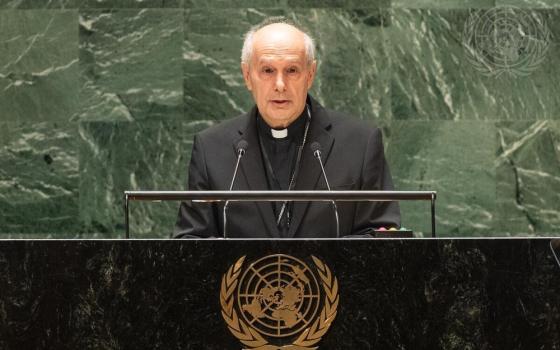(NOTE: An update to this story appears below.)
While stressing the basic “trustworthiness” of a recent blockbuster interview with Pope Francis by Italian journalist Eugenio Scalfari, Fr. Federico Lombardi, the Vatican spokesman, left room on Oct. 2 for the possibility of small imprecisions.
Cardinal Timothy Dolan of New York, who was among the cardinals who elected Francis, today confirmed one such error – a point of fact, as it happens, with important implications for understanding the immediate reaction of Pope Francis to his election.
Dolan told NCR that in contrast to the scene described by Scalfari, there was no moment when Cardinal Jorge Mario Bergoglio of Argentina left the Sistine Chapel after his election but before accepting the papacy.
Instead, Dolan said, Francis accepted immediately and then left the Sistine Chapel, as is customary, to vest in the "room of tears" before returning to greet the cardinals.
“He never left the Sistine Chapel before accepting,” Dolan said. “All that came later.”
Dolan spoke to NCR at the North American College in Rome.
The Scalfari interview was published by the Italian newspaper La Repubblica Oct. 1, setting off shock waves due to the pope’s candor on multiple fronts – calling the trappings of a royal court in the Vatican “leprosy,” complaining that too many church officials are “Vatican-centric,” and so on.
Pressed by reporters on the reliability of the direct quotations, Lombardi said during an Oct. 2 briefing that the text accurately captured the “sense” of what the pope had said, and that if Francis felt his thought had been “gravely misrepresented,” he would have said so.
Nonetheless, Lombardi stopped short of saying that every line was literally as pronounced by the pope, suggesting instead that it represents a new genre of papal speech that’s deliberately informal and not concerned with precision.
Respected French Vatican writer Jean-Marie Guénois confirmed with Scalfari that he didn’t tape the interview, nor did he take notes, so the text was an after-the-fact reconstruction. Scalfari said he showed the text to Francis for his approval, but it’s not clear how closely the pope read it.
At one point in the text, Scalfari raises the question of mysticism with Pope Francis, and asks if he’s had mystical experiences.
Here is the reply as presented by Scalfari, in the English translation La Repubblica published of the interview:
“Rarely. For example, when the conclave elected me Pope. Before I accepted I asked if I could spend a few minutes in the room next to the one with the balcony overlooking the square. My head was completely empty and I was seized by a great anxiety. To make it go way and relax I closed my eyes and made every thought disappear, even the thought of refusing to accept the position, as the liturgical procedure allows. I closed my eyes and I no longer had any anxiety or emotion. At a certain point I was filled with a great light. It lasted a moment, but to me it seemed very long. Then the light faded, I got up suddenly and walked into the room where the cardinals were waiting and the table on which was the act of acceptance. I signed it, the Cardinal Camerlengo countersigned it and then on the balcony there was the ‘Habemus Papam’.”
The suggestion as presented by Scalfari seems to be that, overwhelmed by the magnitude of his election, and possibly thinking about refusing the job, Bergoglio excused himself to go to another room, and only then accepted.
As veteran Italian Vatican writer Andrea Tornielli has pointed out, however, there is no room next to the balcony overlooking St. Peter’s Square, which is located in the middle of a long hallway, raising doubt about the literal accuracy of the quotation.
In any event, Dolan said, the sequence put on the pope’s lips by Scalfari is out of order.
Francis did not hesitate before accepting his election, Dolan said, although there was a moment later when he paused in prayer before stepping out onto the balcony for the “Habemus Papam” announcement.
In effect, what this suggests is that the mystical moment to which Francis referred didn’t convince him to accept the papacy, which he had already done, but rather to feel serene about the burden having already taken it up.
It’s a small point, perhaps, which arguably doesn’t alter the big picture presented by Scalfari. Given that this is the pope, however, one could also argue that small points matter.
* * *
UPDATE: A Vatican spokesperson confirmed this afternoon that the interview with Pope Francis by Italian journalist Eugenio Scalfari ran the risk of “either missing some key details or conflating various moments or events recounted during the oral interview.”
With reference to Francis’ acceptance of the papacy, Fr. Thomas Rosica, who assists the Vatican with English-language media, issued a statement by e-mail that read:
“Cardinals who witnessed the events have categorically stated that the newly elected pope never left the Sistine chapel for a period of reflection before finally accepting the papacy other than his entering the ‘room of tears’ for vesting.”
“There was never any indication of hesitation, a need for serious reflection on the election that had taken place, or rethinking what had befallen him!” Rosica wrote.
Rosica also writes that Scalfari “did not tape his interview with Pope Francis, nor did he take notes, so the text was an after-the-fact reconstruction.”
Rosica suggests that the "mystical moment" referred to in the interview likely occurred in the Vatican's Pauline Chapel, after Francis had accepted his election but before stepping out onto the balcony overlooking St. Peter's Square.
(Follow John Allen on Twitter: @JohnLAllenJr)




